Throughout history, dreams have been a mystical tapestry where the mundane and the metaphysical intertwine, offering insights into the deepest recesses of our psyche. Among the myriad symbols that populate our nocturnal narratives, the brown wolf prowls with profound significance, beckoning an exploration beyond conscious understanding. This essay ventures into the enigmatic realm of dream interpretation, guided by the psychological theories of luminaries like Carl Jung and Sigmund Freud. We unravel the rich tapestry where psychology, culture, and mythology converge, casting the brown wolf not merely as a nighttime specter but as a potent conduit to the human spirit. Embarking on this journey, we seek to decode the hidden messages imparted by the appearance of the brown wolf in our dreams—a symbol that, by its very nature, embodies the primordial dance of our inner wilderness, community ties, and intuitive inklings.
Psychological Foundations of Dream Interpretation
The Enigmatic Presence of Wolves in the Dreamscape: A Psychological Perspective
In the intricate tapestry of the human psyche, dreams offer a profound insight into the inner workings of our mental and emotional realms. Among the recurring motifs in dream analysis, the depiction of animals assumes special significance, and none more so than the wolf. This noble creature, often shrouded in mystery and symbolism, invites a deeper exploration from a psychological standpoint.
The methodological approach for interpreting dreams is rooted in a tapestry of theories and practices, but two foundational figures stand at the vanguard: Sigmund Freud and Carl Jung. Freud’s psychoanalytic perspective postulates that dreams are a manifestation of our subconscious desires and unfulfilled wishes. On the other side of the intellectual spectrum, Jung’s school of thought perceives dreams as bridges to the collective unconscious, a realm where archetypes and humanity’s shared experiences coalesce.
When wolves emerge in the dream world, the Freudian analysis might view these animals as embodiments of repressed emotions or instincts. The wolf, with its raw vitality and primal instincts, could symbolize an aspect of the dreamer’s personality that is untamed or hidden. Perhaps it represents a fear or a desire that lurks beneath the surface of the waking mind, clawing for acknowledgment.
Jungian interpretation, on the other hand, draws on the rich reservoir of cultural and historical associations that wolves carry. In numerous mythologies and folklore, the wolf oscillates between the roles of the wise guide and the ruthless predator. Thus, a wolf appearing in one’s dream could be seen as an animus or anima figure, influential in the development of one’s psyche, or as a shadow archetype, confronting the dreamer with their inner darkness or unexplored potential.
The portrayal of wolves in dreams also invokes the concept of the “Wild,” the uncharted territory of the subconscious where social norms are cast aside and primeval instincts reign supreme. This notion touches upon the psychological principle of liberation from societal strictures, suggesting that the presence of the wolf may catalyze a journey of personal growth and self-discovery, urging the dreamer to listen to their inner voice and possibly embrace aspects of their personality they might not usually display or even be aware of.
Furthermore, the context in which wolves appear in dreams is critical to unpacking their symbolic weight. The emotional resonance of the dream—the fear, awe, or affinity a dreamer feels towards these lupine figures—adds depth to the analysis. Are they friend or foe? Lone wolves or members of a pack? The dynamics at play can provide indicators of the dreamer’s relationships with others and their sense of belonging or isolation within their social environment.
In conclusion, the psychological interpretation of dreams featuring wolves embraces a multidimensional approach that aligns with the depth and plurality of human consciousness. These majestic creatures represent a complex amalgam of instinct, emotion, and symbolism, and their appearance in our nocturnal narratives compels us to consider the vast, untapped reserves of our own psyches. As we venture into the realm of dream interpretation with open minds and hearts, we may discover reflections of our own inner wilderness embodied in the dream-visage of the wolf.
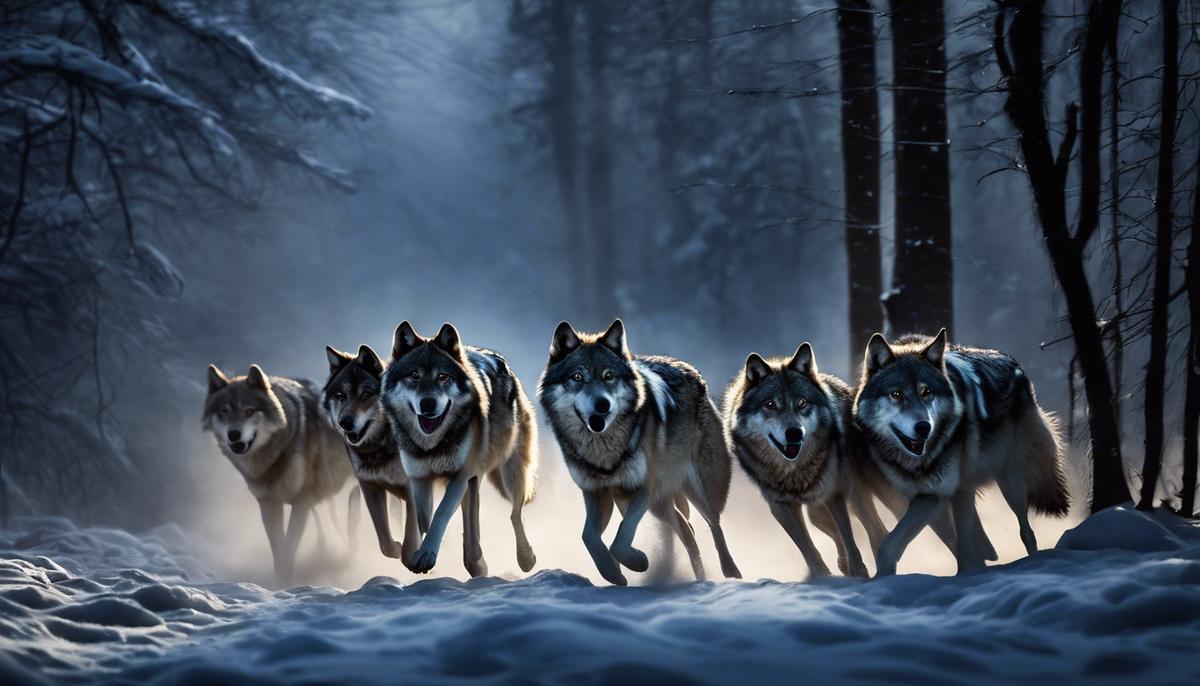
Cultural and Mythological Perspectives
The cultural and mythological contexts in which brown wolves appear in dreams are pivotal to understanding the symbolism that manifests within such visions. Dreams, after all, are not generated in a vacuum; they emerge from the rich loam of human experience and belief, layer upon layer of societal norms, personal anxieties, and folklore.
Across various cultures, the brown wolf is frequently entrenched in mythos as a potent emblem. Take, for instance, the traditions of indigenous North American tribes, where the brown wolf often stands as a totem of guidance, emblematic of loyalty, communication, and social connections. When one considers a dream in which a brown wolf appears, it is essential to question whether these tribal associations are influencing the dream’s interpretation.
In contrast, the narratives of European fairy tales and fables commonly represent the wolf as a cunning and malevolent creature. This dark portrayal could subconsciously weave its way into one’s dream interpretations, coloring the wolf in shades of distrust or fear. The appearance of a brown wolf in a Western dreamer’s nocturnal tale could thus suggest an underlying sense of threat or the approach of an untrustworthy entity.
Furthermore, ancient Norse mythology contributes another layer with its veneration of wolves. The formidable wolves Fenrir and Sköll are woven into the fabric of sagas, embodying both the destructive power of nature and the bravery required to face such forces. Thus, the presence of a brown wolf in a dream may reflect a confrontation with natural forces and the dreamer’s own inner strength or ferocity.
The interpretation of dreams with brown wolves is also considerably nuanced by the dreamer’s personal mythology – the corpus of stories, legends, and religious beliefs that shape an individual’s worldview. An individual who has had direct, positive encounters with brown wolves in the waking world may dream of them in a scenario radically different from one who knows these noble creatures only through grim fairy tales or sensationalized media.
Finally, it is imperative to recognize that the role of brown wolves in dreams may transition in accord with the evolving cultural and mythological landscapes. As the conservation movement reshapes societal views, the wolf transitions from the role of feared predator to a symbol of wilderness conservation and ecological health. Thus, a dream of a brown wolf could be seen as a subconscious alignment with these modern narratives of ecological awareness and the importance of wildlife within natural ecosystems.
In summary, the interpretation of brown wolves in dreams does not reside solely within the framework of dream analysis or psychoanalytic theory. It demands a broader lens, one that examines how the quilt of cultural narratives and mythological contexts drape over the dream landscape. Acknowledging these influences can unveil more profound meanings within the nocturnal encounters with these complex and storied creatures, enhancing our understanding of the self as it is entwined with the collective tapestry of human experience.
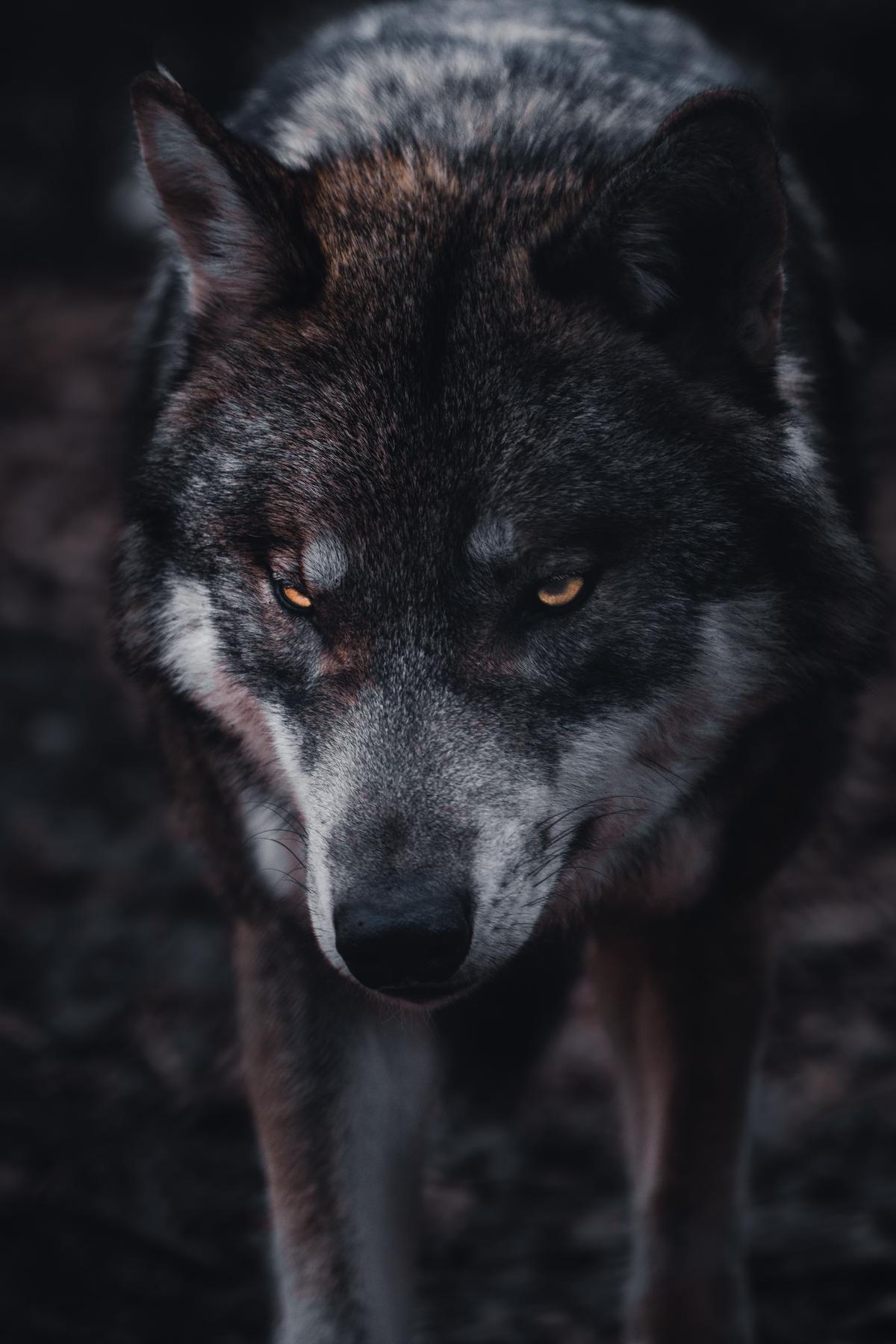
Photo by viramedio on Unsplash
The Brown Wolf as an Archetype
The Importance of the Brown Wolf in Dream Symbolism
Dreams have always served as a profound mirror, reflecting the complexities and enigmas of human consciousness. Among the myriad symbols that inhabit our nocturnal narratives, the brown wolf emerges as a particularly compelling figure, with a rich tapestry of cultural and mythological connotations shaping its interpretation.
In many indigenous North American tribes, the brown wolf stands as a revered totem. It embodies key social virtues such as loyalty, communication, and family. Dreams of a brown wolf might then suggest a need for connection with others or a reflection of one’s role within their community. Conversely, the brown wolf may also appear as a solitary figure, potentially representing the dreamer’s sense of personal freedom or a search for self-reliance.
Contrastingly, European folklore often paints the brown wolf in dark hues. Steeped in tales of Little Red Riding Hood and other fables, the wolf assumes the guise of a cunning predator, embodying deceit and danger. Should a dreamer encounter a brown wolf within the forests of their mind, it might hint at an underlying wariness or mistrust in their waking life.
Turning to the Norse pantheon, wolves are nothing short of legendary, with figures such as Fenrir symbolizing an amalgamation of untamed ferocity and foreboded destruction. As a result, the brown wolf in dreams may resonate with a dreamer’s inner strength or a looming challenge that requires the facing of fears.
The personal mythology that each individual carries — an amalgam of life experiences, emotional imprints, and psychological constructs — inevitably influences the symbolism of the brown wolf. This introspective dimension necessitates a nuanced approach to dream interpretation, recognizing that these creatures may manifest differently within the dreamscape of each person.
As societal values around wildlife shift towards conservation, the brown wolf has come to represent ecological health and wilderness preservation. Therefore, a brown wolf in a dream may signal an awakening to environmental issues or a calling to engage with nature more intimately.
Ultimately, to decipher the essence of brown wolf symbolism in dreams, one must consider the broader cultural narratives and mythological contexts. The act of interpreting these powerful dream motifs can unveil deeper meanings and foster an enriched understanding of the self, while linking us more profoundly with the collective tapestry of human experience.
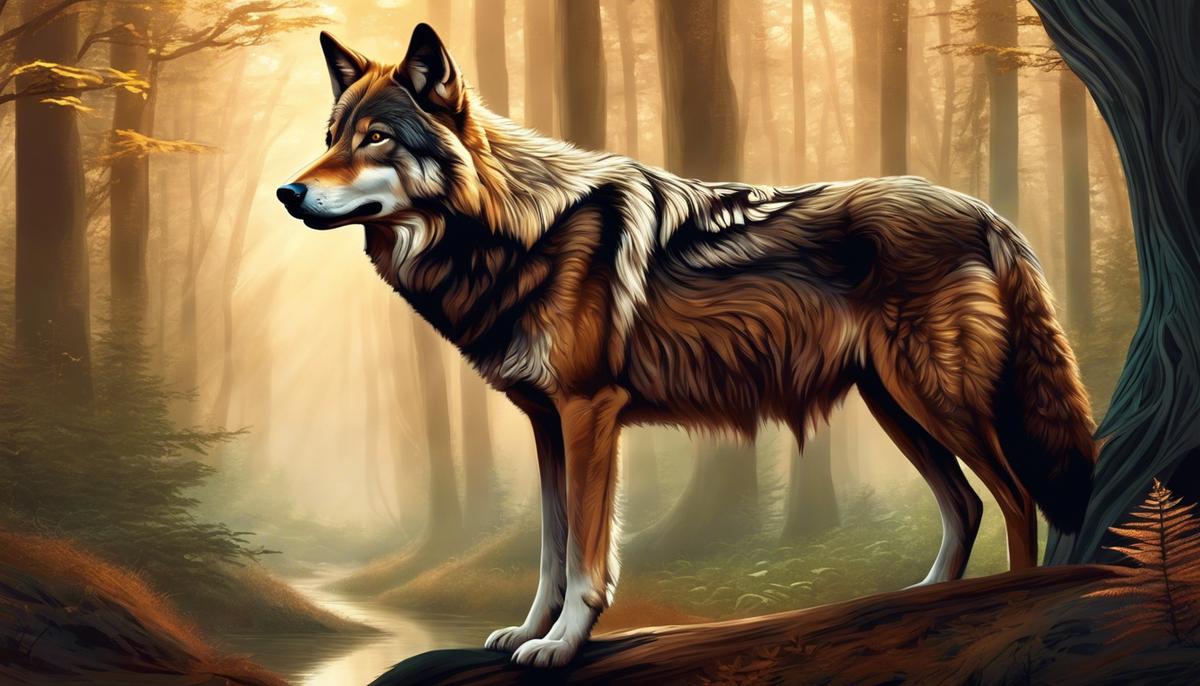
Common Dream Scenarios Involving Brown Wolves
Exploring Common Dream Encounters with Brown Wolves
Amongst the most common dream encounters with brown wolves are scenarios where these animals are either companions or adversaries, imbuing dreams with rich symbolism. Dream analysis reveals that the color brown itself is frequently tied to earthiness, stability, and nurturing, which can inform interpretations of brown wolf motifs.
When dreamers envision themselves interacting peacefully with a brown wolf, it often suggests an alignment with the wolf’s attributes. It could represent a harmonious relationship with one’s instincts or an acceptance of one’s leadership qualities or membership within a community. Such dreams might also symbolize guidance, indicating that the dreamer is being led or should follow an intuitive path akin to how wolves navigate their terrain.
Conversely, encountering an aggressive or threatening brown wolf in a dream could reflect internal conflict. Such dreams might surface when an individual is dealing with issues related to trust, fear of betrayal or facing a challenging situation that requires courage akin to a wolf defending its territory. The threatening wolf could also symbolize an aspect of the dreamer’s life that feels wild or untamed, calling for recognition and perhaps a measure of restraint.
Dreams in which one is being pursued by a brown wolf might touch on themes of evasion or escape. The dreamer could be running from an aspect of self or a situation in waking life that needs confronting. In these scenarios, the wolf embodies the pressure of the pursuit, becoming a catalyst for action or change in the dreamer’s psyche.
An often-overlooked scenario involves observing a pack of brown wolves from a distance. This context may serve as a reflection on one’s social standing or feelings of exclusion. It might signify the dreamer’s observation of group dynamics or reflect on their longing to partake in a collaboration, share in collective wisdom, or seek the comfort of close bonds, just as wolves exist cohesively within their pack structure.
It is crucial to integrate the unique facets of each dream, considering the emotions experienced during the encounter with brown wolves. A dreamer’s subjective feelings offer invaluable clues to the personal significance of these dream events. A threat could be interpreted as transformation if faced bravely, while companionship might be a signal of self-discovery or an invitation to explore less domesticated aspects of the dreamer’s life.
Additionally, morphological details of the brown wolf, such as size, health, or specific behavior, can provide subtleties to the meaning. A nurturing, healthy-looking wolf may suggest a time of personal growth and protection, while a malnourished or sickly wolf could point to neglecting one’s needs or self-care.
Ultimately, recognizing the multifaceted nature of brown wolves in dreams opens avenues for introspection and personal growth. These dream encounters provide windows into the dreamer’s subconscious, presenting opportunities to harmonize instinctual drives with social and cultural constructs. Though each dream is a personal experience, the consistent appearance of brown wolves highlights their potent symbolic value in our collective dream language, enriching our understanding of the human condition.
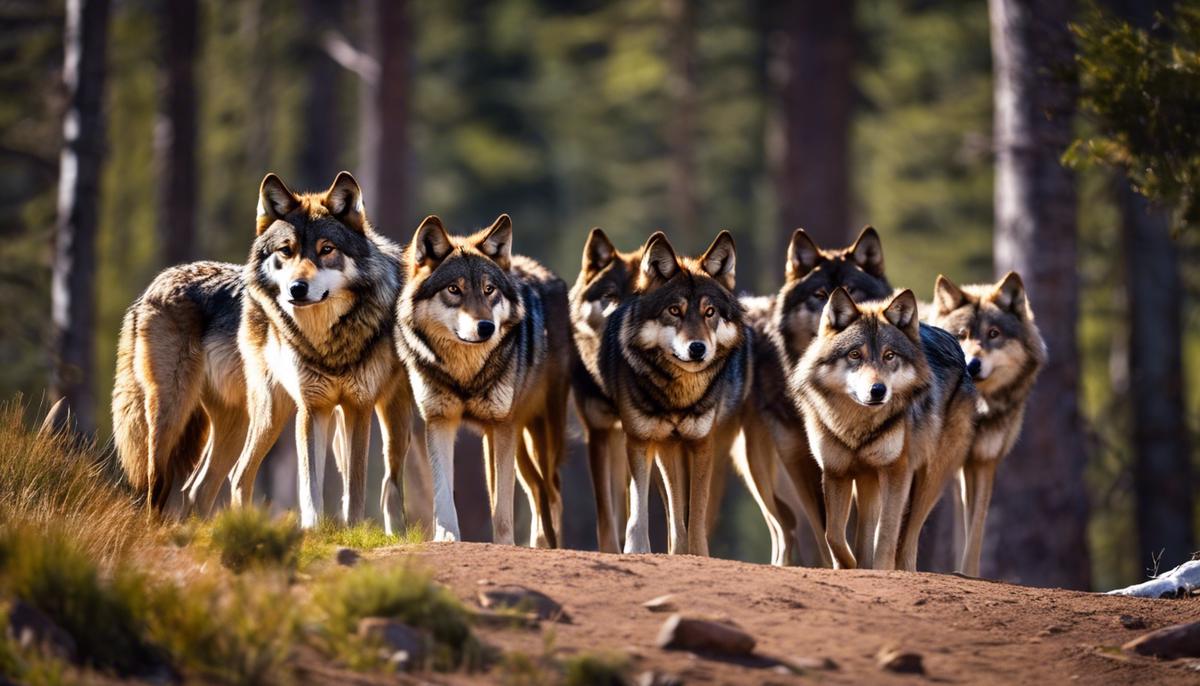
Practical Implications for Dreamers
Dreams: A Window to the Subconscious and the Brown Wolf as a Guide for Personal Development
From the vast expanse of human consciousness emerges the dream, an enduring enigma that paints the canvas of our sleeping minds with symbols and scenarios that elude waking logic. Within this nocturnal domain, the brown wolf emerges not merely as a figure of curiosity but as a poignant guide for introspection and self-development.
When the gentle gaze of a brown wolf graces one’s dream, it may embody a peaceful coexistence with one’s instincts and an implicit encouragement to trust one’s intuition. Such a serene encounter can suggest that the individual is in harmony with their inner nature, a sign to persevere along their current path with confidence.
Conversely, when a dream casts the brown wolf in an aggressive light, the snarls and snaps might symbolize internal conflicts or unresolved tension within oneself. Facing a threat from the wolf could signify a call to address these disturbances, urging the dreamer to confront what they may have been avoiding in their waking life.
The chase, a dream where one is pursued by a brown wolf, potentially mirrors anxiety or a sense of being overwhelmed by life’s pressures. It might hint at the need to examine one’s fears and possibly signify the urge to escape responsibilities. Acknowledging these signals can empower individuals to regain control and reassess their approach to life’s demands.
Observing a pack of brown wolves from afar encapsulates the social aspect of one’s existence, shedding light on their perceived position within their community or network. The pack’s behavior in the dream reflects feelings or attitudes towards social integration or isolation, offering clues on how to navigate interpersonal relationships more effectively.
The emotional landscape of a dream featuring a brown wolf is equally telling. Joy, fear, admiration, or distress—each sentiment unravels a layer of the subconscious, guiding the dreamer toward a deeper understanding of their emotional well-being and how it shapes their perception of reality.
Morphological details, such as the wolf’s size or its condition, inject an added layer of meaning into the dream narrative. A majestic and healthy brown wolf might signify strength and resilience, whereas an ailing one could point to vulnerability or neglected aspects of oneself that require care and attention.
Personal growth is fostered through the integration of these symbols, translating ethereal dream experiences into concrete steps of self-discovery. This process requires the dreamer to balance their primal drives with the constructs of their social and cultural milieu, harmonizing their authentic self with the external world.
The symbolic resonance of brown wolves extends beyond individual dream interpretation to contribute to a collective dream language. Here, they serve as a conduit for shared human experiences, illuminating universal themes of survival, community, and the human-animal bond.
To engage with the symbol of the brown wolf in one’s dreams is to partake in a rite of inner archaeology, unearthing the layers of the psyche to enrich the understanding of the intricate tapestry of the human condition. The dream, in all its cryptic splendor, becomes a beacon for those who dare to delve into its depths, using the brown wolf as a cherished guide along their journey to personal fulfillment.

Future Directions in Dream Research
Exploring the Future of Dream Research: The Nexus of the Brown Wolf in Human Consciousness
Dreams are a fascinating component of the human experience, an enigmatic realm where the conscious and unconscious intersect through vivid imagery and profound symbolism. Within this symbolic menagerie, the brown wolf emerges with recurrent intrigue, prompting researchers to delve deeper into its psychological significance. To fully appreciate and anticipate future scientific inquiries into such dream phenomena involving species like the brown wolf, one must consider a holistic perspective, encapsulating evolving scientific methodologies, cutting-edge technology, and multidisciplinary collaboration.
As the scientific community moves forward, the exploration of dreams involving animals, specifically the brown wolf, stands poised at an exciting frontier. The emergent field of neuroethology, which combines neurobiology and ethology, allows for a systematic scrutiny of dreams, shedding light on how human neural circuits process encounters with various animal archetypes. Advancements in neuroimaging technologies, such as fMRI and PET scans, grant researchers an unprecedented window into the neural substrates associated with dreaming of brown wolves, illuminating the corresponding emotional and cognitive responses.
Furthermore, the utilization of virtual reality (VR) and augmented reality (AR) in dream simulation and research could refine the understanding of participant reactions to brown wolves and other significant symbols within controlled environments. By manipulating variables and creating immersive dream scenarios, such interactive technologies can provide tangible experiential data, expanding the empirical foundations of dream interpretations related to animals.
Another promising area is the integration of machine learning and artificial intelligence (AI) in dream content analysis. By compiling vast datasets of dream reports featuring the brown wolf, AI-driven algorithms can unearth patterns, frequencies, and correlations that might have eluded traditional analytical methods. These findings could bridge subjective dream content with objective interpretative models, enhancing the scientific analysis of such symbols across diverse populations.
Moreover, the application of ecological psychology to the study of dreams promises to explore the interplay between environmental awareness and unconscious symbolism. An increasing awareness of biodiversity loss and habitat destruction could see the brown wolf in dreams attain new significance as a subconscious beacon of ecological conservation and human-nature connectedness.
Further interdisciplinary collaboration between psychology, anthropology, and linguistics can foster a comprehensive understanding of the brown wolf’s portrayal in human dreams across various cultures. As collective narratives evolve with changing societal values, the meanings ascribed to this noble animal in dreams will likely reflect those shifts. Hence, future research must account for the dynamic interrelationship between cultural heritage, personal psyche, and collective consciousness.
The investigation of brown wolf dreams could also be an avenue to explore deeper psychological constructs, such as the human-animal connection and our intrinsic wildness. Understanding how we dream of animals and what they represent could be pivotal in confronting fears, resolving internal conflicts, and fostering emotional growth. It is through dreams that individuals may navigate the primal interface of instinct and intellect, potentially gaining coherent insights into their deepest instincts and societal relations.
It stands to reason that the future of dream research, particularly involving the brown wolf and analogous archetypes, will be rich with multidisciplinary exploration, technological innovation, and evolving interpretative frameworks. Such pursuits do not merely enhance our grasp of dreams but also enrich the tapestry of human understanding, revealing the layers of our collective and individual psyches interconnected with the natural world.
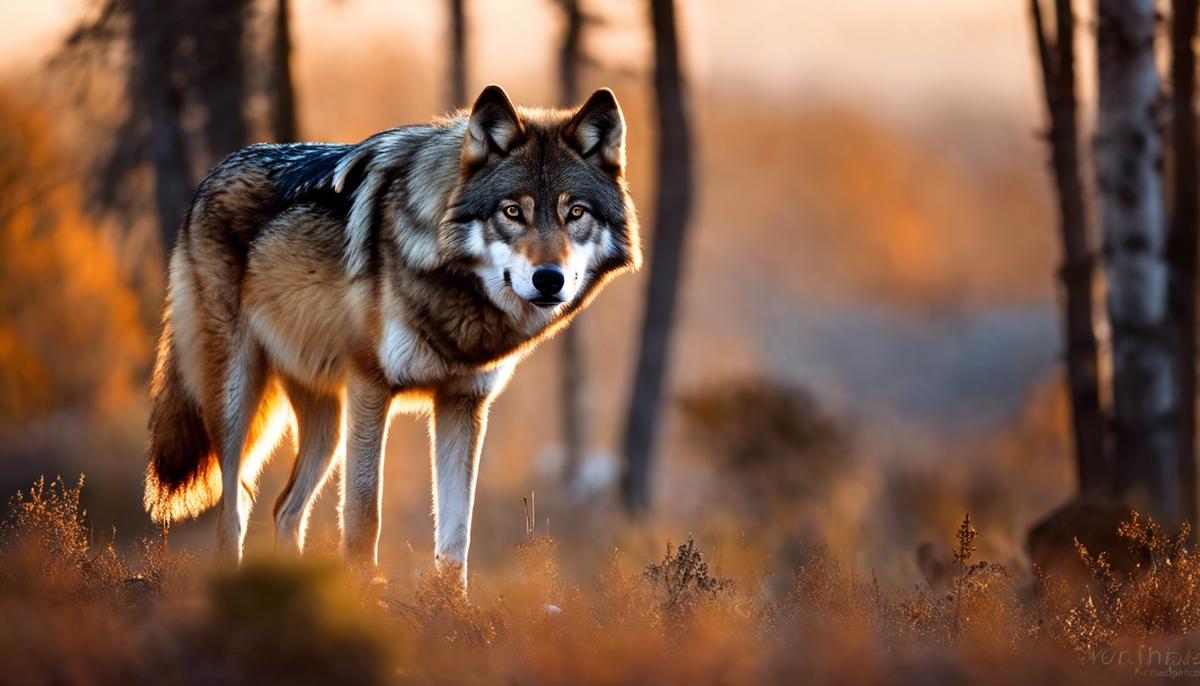
This foray into the world of brown wolf dreams illuminates a path stretching beyond our current horizons, where the boundaries of consciousness await our curious minds. It is a journey that has taken us through the wild terrains of the psyche, guided by ancestral myths and psychological truths. As we stand at the threshold of this exploration, we recognize the power of such dreams to stir introspection and foster personal evolution. They compel us to heed the call of our untamed instincts and to embrace both the shadows and the light within. With each slumber, the brown wolf may offer new riddles wrapped in the fur of ancient wisdom, and as dream interpreters and seekers of self-understanding, we continue to pursue their unraveling, venturing ever deeper into the mysteries of the dreaming mind and the infinite landscapes it conjures.







